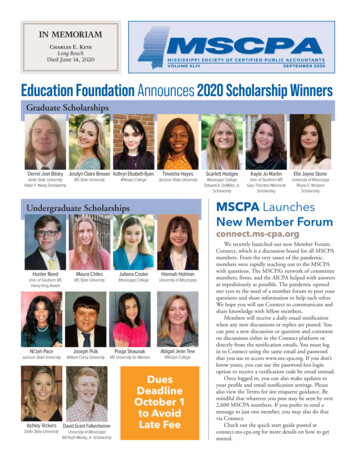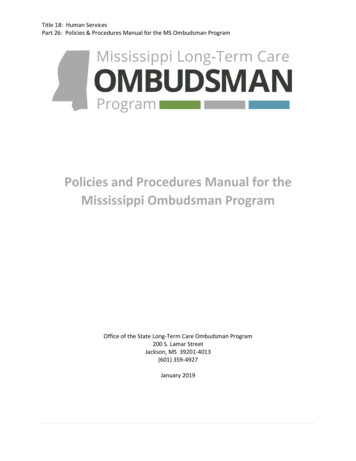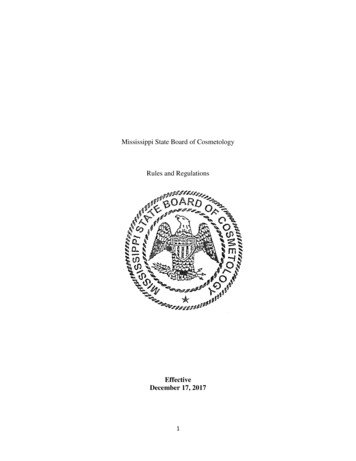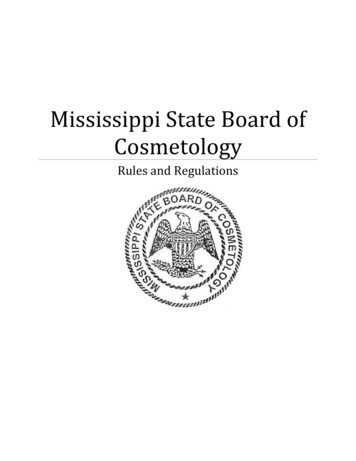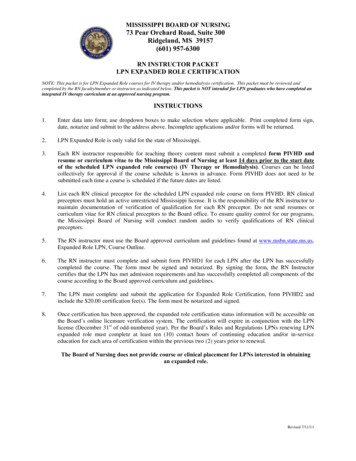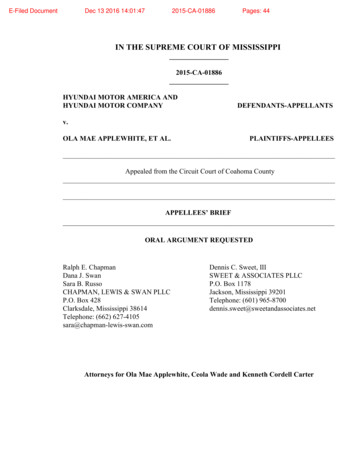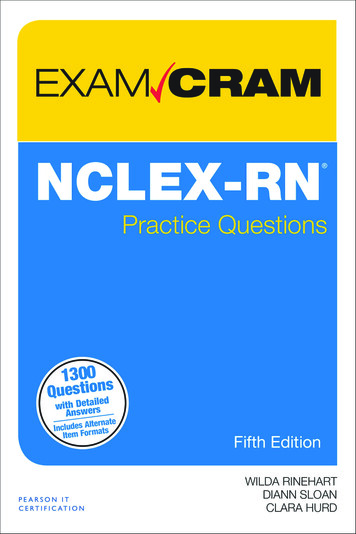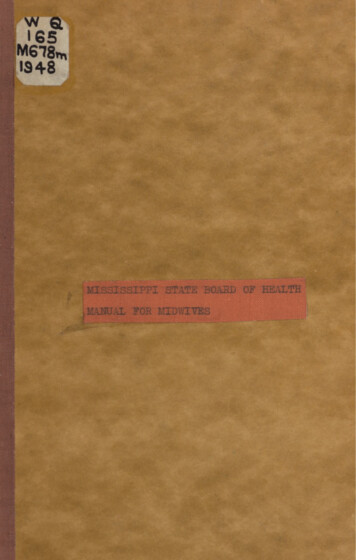
Transcription
MISSISSIPPI STATE 30AHD OF HEALTH MANUAL FOR. MIDWIKBS
MANUAL for MIDWIVESFELIX J. UNDERWOOD, M. D.Executive OfficerMISSISSIPPI STATE BOARD OF HEALTH
TABLE OF CONTENTSPagePreface3rIntroduction-.Chapter I—Qualifications, Permit and Retirement BadgeChapter II—Supervision of Midwives4510Chapter III—Midwife Clubs15Chapter IV—Equipment and Supplies.1.17Chapter V—Things the Midwife Should Know About Pregnancy28Chapter VI—Midwife Instruction to Expectant Mother27Chapter VII—Delivery Supplies29Chapter VIII—The Delivery Room32Chapter IX—Procedure at the Time of Delivery34Chapter X—Care of the Baby43Chapter XI—Care of the Mother47Chapter XII—Reporting the BirthMidwife SongsMidwife Prayer.i.5154-5556
2
Traveling To the Midwife MeetingPREFACEThis MANUAL FOR MIDWIVES is intended as a guideto midwives in the stats. It is to be supplemented by actualdemonstrations given by the public health nurse to the individualmidwife and to groups of midwives.AIMS of the manual and additional instructions are:ToToToTomake the midwives better workersexplain what the state requires of the midwifeteach what the midwife should do and should not dostress the value of the midwife’s keeping in touch withthe county health officer, physicians, public health nurses,and local registrars.To prevent blindness in the newbornTo bring about complete birth registrationTo promote better individual and community healthAppreciation is hereby expressed to county health officers,physicians, registrars and public health nurses who aid in thework.3
INTRODUCTIONThere have been midwives since the beginning of history.In the earliest days an older woman of the community went withthe childbearing mother to a place set aside for that purpose todo what she could to help.There are stories, and a few records, of midwife care onMississippi plantations during the time the state was beingsettled. The first law recorded about midwives in the state wasin 1882. In 1906 a law was written giving them permission topractice.*A survey in 1921 showed 4,209 women practicing midwifery in Mississippi. Ninety percent of them could not reador write, and a great number were old and filled with superstitious ideas. They did not understand the meaning of cleanliness and almost never called a physician for abnormal cases.As time went on and various needs became apparent, it wasthatfor the protection of both the midwives and the mothersfeltand babies they cared for, the midwives needed more trainingand supervision. On April 14, 1921, the State Board of Healthadopted a plan and regulations for improving midwifery in thestate. It was decided that “.the State Supervisor of Midwifery and the county health officers should supervise and instruct the midwives of the state and use every possible means.”** Secfor maintaining the proper standards of midwiferytion 5 of the regulation states: “Following investigation anda satisfactory report to the State Board of Health, a Permit toPractice will be issued.”.The plan provided for a public health nurse to go to areaswhere the groups were largest and the need greatest, to holdstudy courses for the midwives. An outline which dealt with thefundamentals of midwifery was drawn up. If there was countynursing service the work was incorporated into the general nursing program; if there was no nursing service aid was given fromthe state office. Clubs were organized to promote interest and instruction. Club leaders were sent simple, specific directions tostudy in their meetings. The type of meetings gradually changedfrom a disorderly group of women in dirty clothing with littleinterest or attention, to a well-organized, eager, clean group withapproved equipment and improved understanding of their work.Each year our midwives are more nearly approaching the Frenchmeaning of the word midwife—Wise Woman. Hemingway’s Code of 1906, Paragraph 3690 Minutes, meeting of the State Board of Health,April14, 1921
CHAPTER IQUALIFICATIONS, PERMIT AND RETIREMENT BADGEDefinitionA midwife is any woman who makes a practice of attendingwomen during childbirth.Qualifications the Midwife Must HaveA midwife is an important person in her community.Amidwife who helps to bring healthy babies into the world andhelps to keep the mothers well and able to care for their babiesin the right way, is doing a service for her country and herpeople. A safe midwife must:Be able to read and writeBe of good character and intelligenceBe able to do the work expected of a midwifeBe willing to follow instructionsBe clean in person, home and equipmentHave good health; be able to see and hear wellHave recognition in her communityHow to Become a MidwifeApply to the county health department for permission topracticeBe recommended by a physician in the communityHave a physical examination with a chest X-ray, bloodtest and check of visionTake immunizations recommended by the county healthdepartmentStudy the Manual for Midwives and know what it teachesAttend midwife meetings, classes and study courses required by the health departmentAttend deliveries—at least three.—with physicians andother midwivesPrepare complete equipment as directed in the Manual forMidwivesGet a permit to practiceSet up a model delivery room for the public health nurseto inspect
Midwivefs Set Up Model Delivery RoomHow to Keep a Midwife Permit and Stay in Good StandingBe under supervision of the health departmentAttend classes and meetings as directedHave a health examination with a blood test, chest X-rayand check of vision as required by the health departmentHave permit renewed each yearHave everything in midwife bag when called on a caseKeep bag equipped and cleanCooperate with the public health nurseSet up model delivery room once each year; send a reportto the county public health nurse who will send it to theDirector of Public Health Nursing, (If there is not apublic health nurse in the county, send the report to theDirector of Public Health Nursing, Mississippi StateBoard of Health, Jackson, Mississippi.)
RetirementBadgeHow to Get a Retirement BadgeA good midwife who has served her community faithfully isgiven a retirement badge when she is no longer able, or no longerwants to practice. She then becomes a Mary D. Osborne RetiredMidwife. The badge is given when;A midwife realizes she is no longer able to work becauseof her age or healthA physician’s examination shows she should not care formothers and babiesWhen she retires she turns in her permit to practice and thecounty health department gets her retirement badge from theState Board of Health.
MISSISSIPPI STATE BOARD OF HEALTHMIDWIFE PERMITCountyjyfiSQSLNumber1Issued to women who desire to practice midwifery, and who have been investigated and approvedby the State Supervisor of Midwives and the County Health Officer.THIS IS TO CERTIFY THATFREDDIE SPEEDresiding atBAT ST. LODIS, MISSISSIPPIis hereby given a permit to practice midwifery in Mississippi provided she obeys the laws governing this practice and observes the rules and regulations of the State Board of Health as pertainsto the practice of midwifery Permits not renewed yearly are invalid.Midwife PermitA Good MidwifeIs clean in person, home and equipmentHas standard equipment kept in good orderKeeps her bag hung on the wall protected from dust andready for useCalls a physician in difficult or abnormal casesSends certificate of birth to the registrar within 5 daysAttends meetings and classes; is able and willing to learnHas a medical examination as required by the local healthdepartment; takes treatment if neededSends in change of address when she movesWrites the number of permit and postoffice address on allreports and lettersSENDS IN A LIST OF EXPECTANT MOTHERS TO THECOUNTY PUBLIC HEALTH NURSE EACH MONTHHelps the public health nurse and physician in conferenceand clinicTeaches her patients and all other women to go to a privatephysician or to the health center early in pregnancy forexamination and to see the public health nurse each month
Teaches her patients and all other women to go to a privatephysician or the health center six weeks after delivery forexamination of herself and babyTeaches her patients to follow the advice of physicians andpublic health nurses regarding immunization and general care of the babyReports to the county health officer or nurse any personpracticing midwifery without a permitIs a good leader and teacher in her communityNurse Immunizing Baby at Nursing Conference
Nurse Teaching a Group of Mothers at a Community CenterCHAPTER IISUPERVISION OF MIDWIVESPhysical ExaminationEach midwife is to have a physical examination includinga blood test and chest X-ray as required by the health department; she is to take such immunizations as the health department directs. No person suffering from a contagious diseasesuch as tuberculosis, acute venereal disease or any other catchingdisease may practice midwifery. Any midwife who cannot seewell should be examined by an eye specialist and the defectcorrected.
Midwife on Way to Midwife MeetingSupervision and InstructionThe supervision of midwives shall be under the State BoardHealth.Work with the midwives in the various counties shallofbe carried on by the cooperation of the State Board of Healthwith the county health officers, physicians, registrars, publichealth nurses and others interested in the work.Midwives shall, upon receiving notification, attend countymeetings for instruction and yearly renewal of permit. Theyshall attend without notification, local midwife club meetingson the regular day of the month chosen for such meetings. Anymidwife failing to attend meetings regularly may have her permit suspended at the discretion of the health officer. A reportof the meeting is sent to the county public health nurse, whosends it to the Director of Public Health Nursing, State Boardof Health.
County Midwife MeetingA record should be filled out by the nurse when shemakes her initial contact with the midwife. Other informationobtained by the nurse should be written on the record under theproper headings. A record for each individual midwife shallbe on file in the office of the Director of Public Health Nursing,State Board of Health and in the county health department.Public health nurses will teach midwives in groups, bydemonstrations in the homes of the midwives and their prospective patients, and at the health center or club meetings. Theywill give further instruction to individual midwives in theirhomes, the homes of their patients and at the health center.Midwives are urged to seek counsel and help from thepublic health nurse and to report the names of their prospectivemothers to the nurse so that the mother may have an examination including an examination of urine and blood, and furtherinstruction as to the care of herself and baby.The purpose of the instruction given by the public healthnurse is to bring about good care of the mother; to help the babyto be well born; and to teach the mother how to care for herself and her baby.
Public Health Nurse Instructing MidwivesDutiesMidwife’s duty to mother and baby—Medical care:Teach the mother to have medical examinationand after baby comesbeforeNursing supervision:Report all cases to public health nurseEncourage patient to see nurse every monthSafe delivery:See that everything about mother and baby is keptclean. Call a physician if anything unusual happens.After care:See lessons on “Care of Mother” and “Care of Baby.”Birth registration:Send certificate to county registrar within 5 daysafter baby comes
Expectant Mother Examined with Midwife PresentMidwife’s duty to health department—Attend meetings and classesGet new permit each yearReport all cases engaged to public health nurseTeach patients to attend medical and nursing conferencesNotify public health nurse immediately of birthsRegister births promptlyAssist in clinics, conferences and community workMidwife’s duty to private physician—Call promptly if neededGive careful account of patient’s conditionHelp physician as he directsGive after-care to mother and babyMother’s duty to midwife—Engage service early in pregnancy—at least 5 monthsbefore baby is dueReport for medical care and nursing supervisionPrepare supplies as taught by midwifeCall midwife as »oon as labor beginsFollow midwife’s teachings
CHAPTER IIIMIDWIFE CLUBSNurse Teaching Midwives at Monthly Club MeetingOrganizationThe standard of midwifery in the state has been raised bymeans of the organization of midwife clubs. It is the duty ofeach midwife in the state to attend a midwife club meeting oncea month, not only for her own sake, but for the sake of themothers and babies she cares for. The number of clubs in acounty depends upon the number of midwives and their location.Midwives are to wear white uniforms and specified caps, andbring their midwife bag to all meetings.Each club shall have a leader and a secretary.The duties of the leader shall be to—Lead the meetingInspect bagsKeep and give out eye dropsTeach the midwife songsSend to the county public health nurse a report of the
monthly meeting signed with the name of the leader andher postoffice address.In counties where there is no public health nurse, thereport is to be sent to the Director of Public HealthNursing, Mississippi State Board of Health, Jackson,Mississippi.The duties of the secretary shall be to—Call the rollMark in the book those presentMark in the book those absentKeep and read minutes of the meetingRead a chapter in the manual and talk about itHelp write birth certificatesWrite the report of the meetingActivitiesStudy Manual for MidwivesPlan with public health nurse for work in the communityLearn what new things to teach mothersInspect midwife bag and suppliesMonthly Club Meeting with Secretary Reading from Manual
CHAPTER IVEQUIPMENT AND SUPPLIESUniformA plain white uniform and cap are to be worn to the clubmeetings and when assisting in clinics or conferences.Pattern of Cap worn at Meetings—3 inches wideCAP, MASK and GOWN are to be worn at time of deliveryThe CAP is a square piece of domestic 27 inches by 27inches.The MASK is made of soft white cloth of two thicknesses,three inches by five inches, stitched around the edges. A piece oftape fifteen inches long is fastened at each corner.The GOWN is made with short sleeves above the elbow,open in back and tied with tape.
BagOuter leather or heavy fabric bag to keep equipment cleanInner bag of white washable materialCap, mask, gownTwo towels or cloths for drying handsWooden nail cleanerHand brushBottle of synol soapBottle of lysolBlunt scissorsSilver nitrate, 1 percent in ampulesSterile tape to tie cordSterile band and cord dressingSterile eye wipesFunnel with rectal tube; small aluminum funnel, number22 catheterManual for MidwivesMidwife permit pinned in last page of manualBirth certificate bookNO INSTRUMENTS OTHER THAN THOSE LISTEDABOVE SHALL BE CARRIED OR USED BY THE MIDWIVES
Two Pockets on One Side ofInside of BagFive Pockets on OtherSide of Inside of BagEquipmentBag and FunnelBagOuterBag
Care of EquipmentINNER BAG: Wash, boil, starch, dry in the sun, and ironafter each case. The midwife shall have a second INNER BAGat home in which to place equipment for the next case.CAP, MASK, GOWN: Wash, boil, dry in the sun, iron; wraptogether in a clean white cloth three-fourths of a yard square.TOWELS: Wash, boil, dry in the sun, iron, wrap in a cleancloth, then in heavy brown paper and bake thirty minutes in aslow oven in which a pan of water has been placed. Removepaper wrapping.HAND BRUSH, WOODEN NAIL CLEANER, SCISSORS:Boil ten minutes before using; after using, wash thoroughly withsoap and water and boil ten minutes before returning to bag.Dry thoroughly to keep scissors free from rust.FUNNEL AND RECTAL TUBE: Carry in a small washable bag, 7 inches x 12 inches, made with a draw string. Afteruse, the funnel with the tube shall be cleaned with soap andwater, rinsed well, dropped into the small bag and boiled forten minutes. The funnel with tube still in bag, shall be hungup to dry and not removed from bag until used again.CORD TAPE: Use flat silk tape wound on a spool. Itcan be bought at most drug stores in a glass bottle with cork topwhich is not to be removed, and screw cap. Remove only enoughto use each time; replace screw cap after each use.BAND, CORD DRESSINGS, EYE WIPES: Make fromold soft white cloth. Thoroughly wash in soap and water, rinsewell, dry in the sun, iron with a hot iron on a clean cloth. Wrapin a clean cloth, then in heavy brown paper and bake thirtyminutes in a slow oven in which a pan of water has been placed.Remove paper wrapping.
Leader Inspecting Midwives Bags and Equipment
EYE WIPES2 Inches by 2 Inches—4 pieces.1 piece 10 inches by 10 inches, for wrapping.HOW TO FOLD THE EYE WIPES10 inches by10 inchesEye WipesIn placeFirst FoldFoldedCORD DRESSINGS5 Inches By 20 InchesBandDressing When Doubled4 Inches By 4 InchesHOW TO FOLD DRESSINGS10 inches by10 inchesDressingIn PlaceFirst FoldFolded2 pieces 4 inches by 8 inches, doubled, then cut half waydown the middle.1 piece 4 inches by 8 inches, doubled.These 3 pieces make the cord dressing.1 piece 5 inches by 20 inches, plain single piece, withoutseam or hem, for band.1 piece 10 inches by 10 inches, for wrapping band and corddressing.TWO PACKAGES OF CORD DRESSING AND TWOPACKAGES OF EYE WIPES SHALL BE IN THE MIDWIFE’S BAG AT ALL TIMES.
CHAPTER VTHINGS THE MIDWIFE SHOULD KNOWABOUT PREGNANCYPregnancy is the length of time, 280 days or 10 moonmonths, from conception to delivery, during which time thebaby grows in the womb of the mother. Conception takes placewhen the female egg is united with the male egg.To find out the date the baby is expected, add seven daysto the first day of the last monthly period and count back threemonths.How the Baby Grows* (almost 1/3 actual size)*Courtesy of Maternity Center Association, New York City.Signs and Symptoms of PregnancyMonthly flow stopsMorning sickness in some women. If present usually stopsafter eight to twelve weeks.Tenderness and enlargement of breasts usually noticed inthe second month.Darkening of nipplesFrequent passing of urineMovement of the baby at four and one-half to five months.This is called “quickening’’In the last month when the baby drops the stomach region isflatter, the waistline is lower, the navel bulges, and themother breathes easier. This is called “lightening.”
Female Organs of ReproductionCourtesy of Denoyer-Geppert Company, Chicago, Illinois.
At the time a mother engages the midwife to care for her,the midwife shall note if the pregnant woman has any of thefollowing signs, and if so, the midwife shall not engage to attend the case unless advised to do so by a physician. In case anyof these signs appear after the midwife is engaged for the case,she shall seek the advice of a physician:Continued or severe vomitingContinued or severe headacheConstipationDizzinessDimness of vision, spots before the eyes, or puffinessaround the eyesSwelling of face, hands, ankles or feetNo movement of the baby felt by mother in later monthsBleeding or staining in small amounts during pregnancyContinued free vaginal dischargeSores or warts on the genitalsUnnatural signs such as miscarriageScanty urineAlbumin in urine; (ask public health nurse for this information)Fits or convulsionsThe midwife shall not, unless advised by a physician to doas a patient a woman who is dwarfed, deformed oracceptso,orone known to be suffering from any disease. Thesecrippled,rules are for the protection of the midwife as well as thepatient. Some county health departments require all womenwho engage midwives to have a medical examination beforedelivery.
Midwife Advising Pregnant Woman
CHAPTER VIMIDWIFE INSTRUCTION TO EXPECTANT MOTHERThe midwife shall visit the home of the expectant motherto instruct her and to inspect her supplies. She shall advise thepregnant woman to:Eat plain and simply cooked toods—Milk: One quart a day. Drink it or use it in cooking, as insoups, custards, and creamed dishes. Three tablespoonsof dried skimmed milk equal one glass of fresh skimmedmilk.Vegetables: Three servings each day. At least one should beleafy green or yellow vegetable such as collards, turnipgreens, mustard, sweet potatoes, rutabaga. A raw vegetable such as cabbage, greens, or carrots should be eateneach day.Fruits’. Three servings each day. Two servings should betomatoes, orange, grapefruit, melon, or other raw fruit.Eggs: At least one every day.Lean meat, fish, chicken, dried beans or peas: One largeserving each day. Liver, kidneys, and heart are especiallygood.Whole grain or enriched cereals and bread'. Three or fourservings a day. Whole grain foods such as oatmeal,cracked wheat cereals, cracked wheat bread and wholewheat bread, are particularly good.Butter or margarinetablespoons a day.;A moderate amount.One to twoFish liver oils: As recommended by the physician or countyhealth officer.Several glasses of water a day in addition to milk,soup, tea, coffee and fruit juice.Fluids:Choose simple foods; do not eat much sweets, fats, orstarchy foods such as pies, candy, macaroni, rice, saltpork, fat back, salad dressing, or fried foods. Ask thephysician about your weight.
Keep the bowels and kidneys activeTake a daily bath; take a sponge bath after the seventh monthGive extra care to the teeth; be examined by a dentist and havecorrections if needed.Wear comfortable clothing; no tight bands, corsets, gartershigh heels or tight shoes.Take light exercise but do no heavy liftingTake a nap or rest period during the dayHave fresh air day and nightTake no medicine or treatment unless advised by a physicianHave urine examined regularlyNot worry over conditionPrepare supplies early for mother and babySelect name for the baby before time for the baby to comeGo to a physician or to the health center for a physical examination during early pregnancy. The life of the baby begins10 moon months before it is born. If the mother is givengood care during this time, the baby is having good care.Attend nursing conferences for instruction. The midwife shallsend the name and address of the pregnant woman to thepublic health nurse who may visit in the home and givefurther instructions.Let the midwife know the date of “quickening”Let the midwife know when the baby drops; to send for her atthe first signs of labor; and to notify the county health department when the baby is born. Breast feed her baby. The midwife should teach all through thewoman’s pregnancy that:Breast milk is clean and free from germs and dirt if thenipples are kept cleanBreast milk is usually more nourishing, never sourBreast milk helps make strong, healthy babiesBreast milk is the most nearly perfect food for most babiesBreast milk is nature’s methodBreast fed babies are usually the best fed babies
CHAPTER VIIDELIVERY SUPPLIESIn addition to the midwife equipment the following articlesare needed, and the midwife shall teach the prospective motherhow to prepare and have in readiness the necessary supplies:For the MotherSheetsPillow casesTowelsNight gownsClean white rags; washed, boiled, ironed and wrapped in aclean cloth or pillow casePads, sterilized at home in same manner as cord dressingsor boxed pads bought at a storeNewspaper pads; at least threeTwo basinsQuart glass jarWash tubSlop jar or bucketBedpanSterile absorbent cottonSoapPaper Pads Prepared for Delivery
For the BabyBelly bands: Three, 5x20 inches; soft, washed, material;unhemmed; to be worn until the cord drops offShirts: Four, cotton and wool or silk and wool, dependingon seasonDiape*s: Washed, boiled, dried in the sunFlannelette squares: Two or threeDresses: Three open down back or fasten on shouldersSaftey pins: Large and smallSoft clean cloths for bath rags and towelsSoap: Mild, unscentedOil to cleanse babyTub or large basin for bathing babySeparate bed or baby basket or box with padRubber sheet for baby bedSmall sheetsSmall light blanketsNurse DemonstratesSupplies for the Baby
Needed at the time of DeliveryGood fireGood lightBoiled water, hot and coldMidwife equipmentClean bedding, gowns, stockings and pads for motherSupplies for receiving and dressing babyTwo large basins, dipper, wash tub, slop jar or bucketSaucer, two quart glass jars, spoon: To be boiled with handbrush, nail stick and scissors in one basin, using the otherbasin as coverPaper pads for bed; newspaper for floor and wasteTable, chair or other flat surface on which to spread cleantowel or cloth. On this place eye wipes, eye drops, scissorson saucer, cord tape, sterile band and cord dressing,sterile pads, and sterile towels or cloths.On another chair or table near by place basin for washinghandsOn floor near wash basin place tub; soiled sheets may beplaced in the tub and hands rinsed over it.On chair or stool near bed place basin of lysol solution—oneteaspoonful of lysol to two quarts of water.
CHAPTER VIIITHE DELIVERY ROOMThe ROOM for the patient should have all unnecessaryarticles removed, be thoroughly cleaned and well-lighted, andhave fresh air, but not a draft.The patient should be delivered on a CLEAN BED. If thebed is low it may be raised by placing wooden blocks under thelegs of the bed. If it is not firm, boards should be placed underthe mattress. The mattress should be protected with newspapers.Over this is spread the undersheet, well tucked in and pinned atthe corners of the mattress.A newspaper pad is placed on this sheet to remain underthe patient’s hips after delivery. A second newspaper pad isplaced over the edge of this pad, well up under the shoulders andextending to the side of the bed. A third newspaper pad isthen placed over the edge of this pad extending over the edgeof the bed to drain into the slop jar. The two top pads are withdrawn after delivery, leaving the bed clean and protected by thebottom pad. The patient shall be covered with a clean sheet andblankets if needed, and wear a clean night gown and cleanstockings.The newspaper pads may be made by taking twelve or morethicknesses of newspapers opened full size, slipped into a freshlywashed, boiled, and ironed white cloth, folded and stretched soas to hold newspaper pad.The floor around the bed may be protected by newspapers.Newspaper pans for holding waste can be made by rolling theedges of a newspaper to form a round pan with folded newspaper laid in the bottom. These newspaper pans may be usedto receive all waste, such as discarded eye wipes, pads, afterbirth. The waste shall be burned or buried.
Deliv ryforUpSetRo m33
CHAPTER IXPROCEDURE AT THE TIME OF DELIVERYPreparation of RoomFollow instructions in Chapter VIIIPreparation of MotherThe midwife shall teach the mother to prepare all of hersupplies early. At the first signs of labor the mother shouldget ready the things she will need, take a warm sponge bath,put on a clean gown, and call the midwife. When the midwifegets to the home she shall question the woman about her condition and about the preparations that have been made. She shallthen scrub her hands thoroughly and, if the bag of waters hasnot broken, shall give the patient a warm soap suds enema. Thisenema is given to make the patient more comfortable and togive more room during delivery, but most important of all tokeep the patient clean during delivery. Do not give the enemaif the bag of waters has broken.To prepare the enema: A quart of luke warm suds is made in aclean quart glass jar. The tip of the tube is wet with the soapsuds and put about three inches into the rectum. Thepatient may hold the tube in place while the midwife poursin the soap suds slowly. Urge the patient to hold the fluidfor a short time.The midwife shall again scrub her hands thoroughly anddisinfect them with lysol solution—one teaspoonful of lysol to twoquarts of boiled water.She shall then bathe the external parts of the mother.To bathe the external parts: Fill the quart jar with boiled waterslightly warm. While patient sits over slop jar or bedpan,pour water gently over external parts.
Midwife Dressing for Delivery
Preparation of the MidwifeThe midwife shall be clean in person, wear a clean washabledress, a cap, mask and gown at the time of delivery. She shallcover her head before she begins the preparation of the room,utensils and patient, and shall put on mask and gown when thepatient goes to bed at the second stage of labor.To prepare HANDS for delivery: The midwife shall keep herfinger nails short. She shall boil brush and nail stick, andclean under the nails with a wooden nail cleaner; scrubthe hands and arms up to the elbows with hand brush, synolsoap and boiled water for five minutes, paying particularattention to the nails and inner surfaces of the fingers.Scrub above elbows to below wrists, at the roots of nails,knuckles of fingers and thumbs, front of fingers andpalms, back of fingers and hands, and between fingers.She shall then have a helper pour boiled water which hasbeen cooled, over her hands and arms while she holds herhands with the fingers pointing upward. She shall dryher arms with a sterile towel and shall then soak her hands,in lysol solution—one teaspoonful of lysol to two quartsof boiled water—for five minutes. After the hands arecleansed and disinfected she should not touch anything before handling the patient. If she does she should again scrubher hands and disinfect them. During the delivery themidwife shall soak her hands in the basin of lysol solutionnear the bed. It is necessary to do this frequently to keephands and mother clean. Midwives should practice scrubbinghands at midwife meetings and at home, and should teachthose who care for the mother and baby to have clean hands.Warning to MidwivesUnder no circumstances shall the midwife pass her fingeror any instrument into the birth canal of a woman for thepurpose of making examination, to remove the afterbirth, orfor any oth
Nursing, Mississippi State Board of Health, Jackson, Mississippi. The duties ofthesecretary shallbe to— Call theroll Mark in the book thosepresent Markinthebookthoseabsent Keep and read minutes

